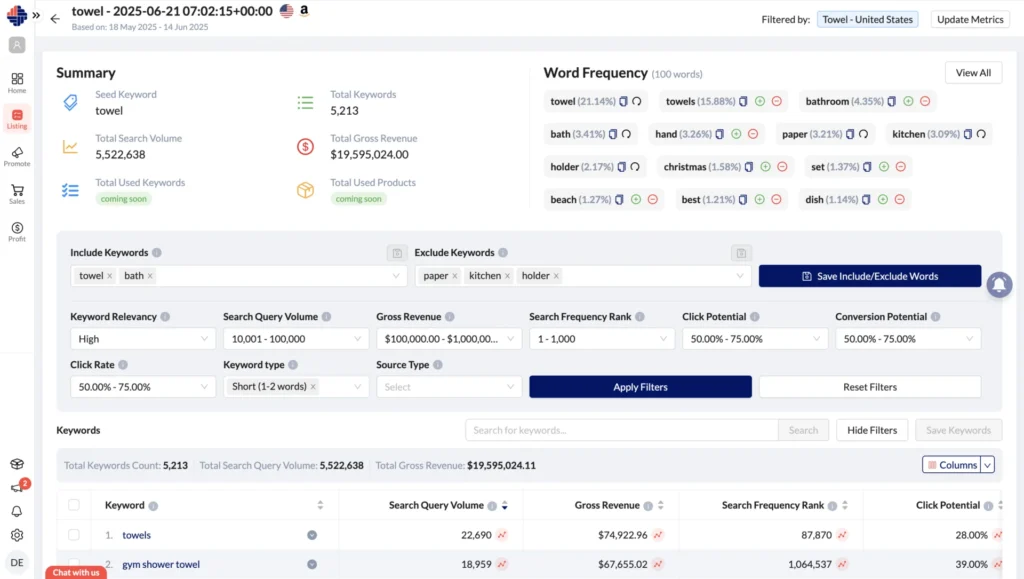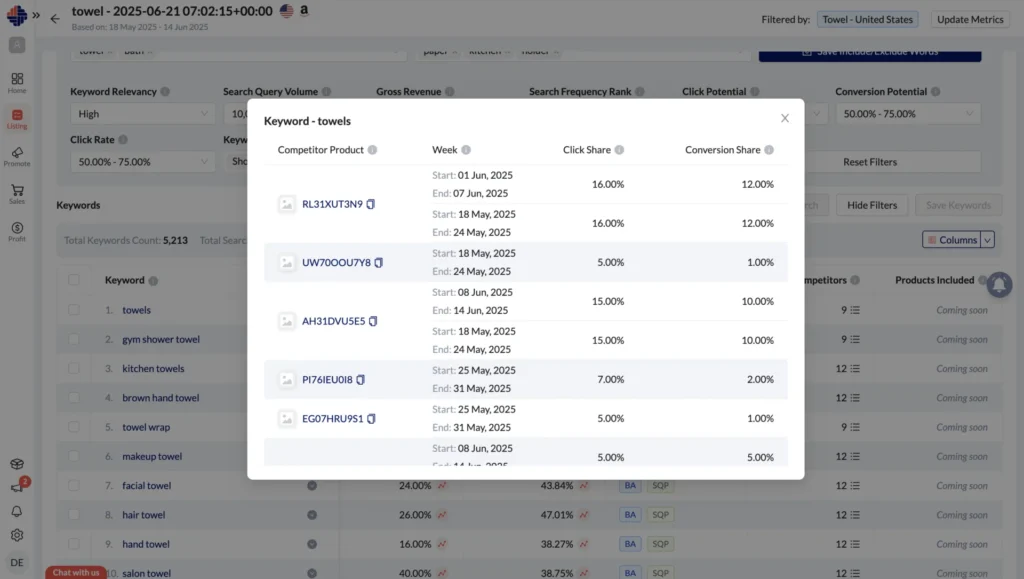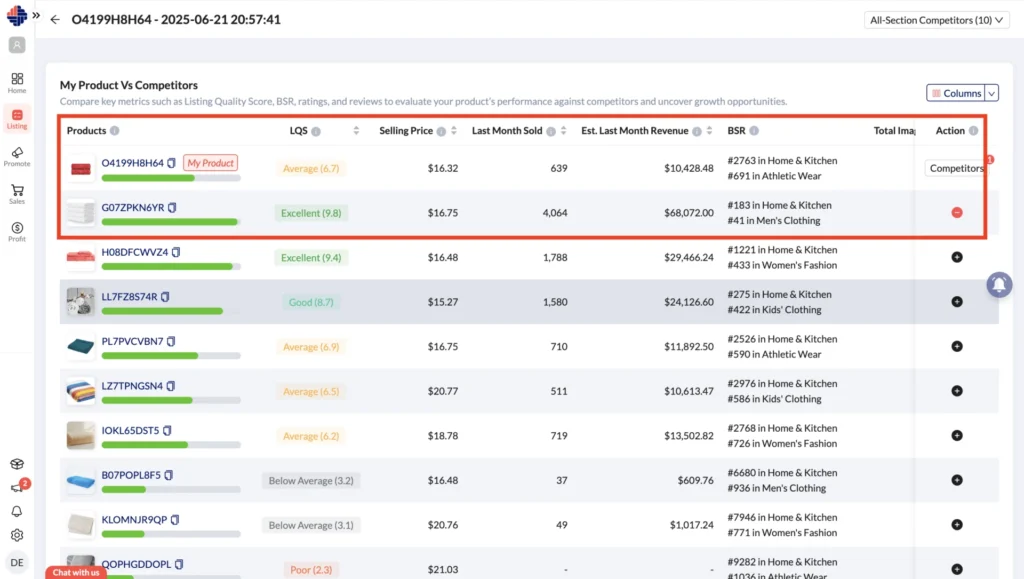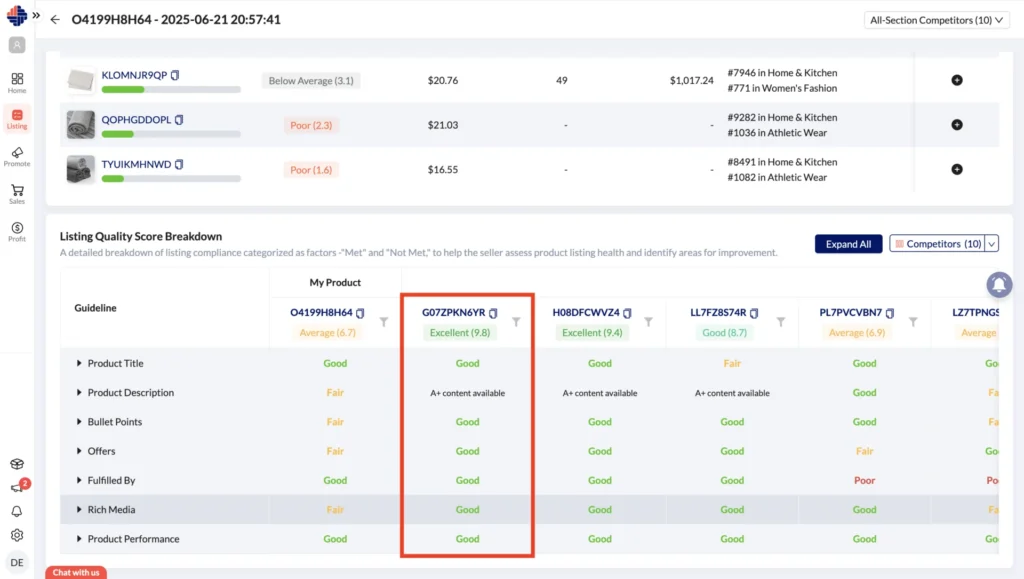How to Find Competitor Keywords on Amazon (Step-by-Step Guide for Sellers)

Table of Contents
To find competitor keywords on Amazon, start by analyzing top-ranking ASINs and the search terms they rank for. With an Amazon keyword research tool like KwickMetrics, you can uncover competitors’ high-traffic keywords, optimize your listings, and drive more visibility and sales.
Mastering Amazon Competitor Keywords: Step-by-Step Guide
If you want to improve your product rankings, drive more relevant traffic, and outperform the competition, mastering how to find competitors keywords on Amazon is essential. Sellers who understand what keywords their competitors use—and how they convert—can build smarter product listings and more profitable campaigns.
In this step-by-step guide, we’ll show you how to uncover high-performing Amazon competitor keywords, analyze them using real performance metrics, and optimize your listings to gain an edge. Whether you’re a new seller or an established brand, these insights are key to staying competitive.
Step 1: Discover High-Value Keywords and Competitor ASINs
Start your research using the Keyword Researcher tool inside the Listing Management module of KwickMetrics. This tool functions as an advanced Amazon keyword search tool powered by actual marketplace data.
Begin by entering a seed keyword related to your product. The tool will instantly fetch:
- Related keyword suggestions using Amazon’s real-time data
- Amazon keyword search volume and search frequency rank
- Click potential and conversion potential
- A list of top-ranking competitor ASINs for each keyword
- Revenue estimations for those keywords
- Click-through trends for each keyword
This first step is where Amazon competitor analysis begins. You’re not only learning which keywords matter—but also which sellers are winning with them.
Example: Searching “organic baby lotion” may reveal profitable long-tail keywords like “unscented baby lotion” or “eczema lotion for babies,” along with the top ASINs generating the most revenue for each.
You’re using a keyword search tool that goes beyond volume—it shows how keywords are performing for real competitors.



Step 2: Build a Strategic Keyword Bank
Once you’ve uncovered a wide set of keyword data and performance metrics, the next step is to narrow down your target keywords.
In the Keyword Researcher tool, you can:
- Select high-opportunity keywords based on amazon keyword volume, search ranking, conversion potential, and competitor data
- Save them to a personalized Keyword Bank
- Automatically associate top competitors for each saved keyword
This Amazon Keyword Research process helps you turn research into strategy. By selecting keywords that are both high in search volume and realistic to rank for, you’re optimizing your listing content and ad targeting at the same time.
Pro Tip: When building your keyword list, consider both high-volume and high-intent keywords. Often, lower-volume terms convert better—especially if your competitors are ranking well with them.
Using this method, you’re effectively combining the benefits of an Amazon keyword planner and an Amazon competitor analyzer—in one place.
Step 3: Analyze Competitor Listings in Detail
With your keywords and associated competitors in place, shift your focus to in-depth competitor listing analysis using the Listing Analyser.
Here’s what you can do:
- Select competitor ASINs from your keyword research
- Compare key competitor listing metrics like:
- Listing Quality Score
- Best Seller Rank (BSR)
- Ratings and reviews
- Fulfillment methods
- Pricing and offers
- Product images, videos, and A+ Content
- Review detailed Listing Quality Score Breakdown to evaluate:
- Title optimization
- Bullet point clarity
- Description formatting
- Offer strength and delivery options
- Performance indicators
A detailed breakdown of listing compliance metrics, categorized as “Aligned” or “Not Aligned” based on Amazon’s guidelines, helps sellers assess product listing health, identify improvement areas, and compare performance with top competitors. Each metric is also represented as Good, Fair, or Poor for quick visual assessment.
Example: You might find that while your product title is optimized, your bullet points or images are lacking—areas where top competitors are excelling.
This step is crucial for making data-backed listing improvements and is ideal for sellers seeking comprehensive Amazon listing services without the guesswork.


Why this Process Works:
Most tools focus solely on amazon keyword research or volume metrics. But KwickMetrics combines:
✅ In-depth keyword search
✅ Real-time competitor performance insights
✅ Side-by-side listing comparisons
With this approach, you’re not just learning how to find competitors keywords on Amazon you’re also gaining the tools to act on that data and optimize your own listings for better performance.
You’ll understand:
- Which keywords drive actual sales (not just impressions)
- Which ASINs are dominating those keywords
- What your competitors are doing better (or worse)
- Where you can improve to outrank and out convert them
Final Thoughts
Finding and leveraging Amazon competitor keywords is one of the smartest ways to scale your listings, increase visibility, and convert more shoppers.
With KwickMetrics, you have access to the best Amazon keyword tool for combining keyword research, listing optimization, and competitor analysis—without needing multiple platforms.
So whether you’re searching for Amazon keyword search volume, building a keyword bank, or doing full Amazon competitor analysis, this process sets you up for long-term success.
Ready to gain the upper hand in your niche?
Start using Keyword Researcher and Listing Analyser on KwickMetrics to discover, compare, and dominate—step by step.
Get Your Questions Answered (FAQ)
The best way is to use an Amazon-specific keyword research tool like KwickMetrics. By entering a seed keyword, you can identify high-performing keywords and see which ASINs (competitors) rank for them—along with insights like revenue, click-through rate, and conversion potential.
Amazon keyword search volume indicates how often a keyword is searched. When combined with competitor data, it shows whether top-performing ASINs are capturing traffic from high-volume terms, giving you valuable insights into what drives their success.
Keyword Researcher helps you find profitable keywords and identify top ASINs ranking for them. Listing Analyser lets you compare your product against those ASINs using metrics like Listing Quality Score, pricing, fulfillment, and A+ content.
After identifying competitor keywords and analyzing listings, you can improve your product title, bullet points, description, images, and offers to better align with what’s working for your competitors, boosting your visibility and conversion.
Not necessarily. There are multiple tools available for Amazon keyword research and competitor analysis — ranging from basic free tools to advanced paid platforms. The right choice depends on your goals, budget, and how deep you want to go.
KwickMetrics consolidates several key insights — including search volume, keyword performance, competitor ASINs, listing comparisons, and optimization suggestions — all in one intuitive dashboard. It presents raw Amazon data in a way that’s easy to understand and act on.
Ultimately, it’s up to each seller to decide whether they want to use multiple tools or prefer an all-in-one solution like KwickMetrics.